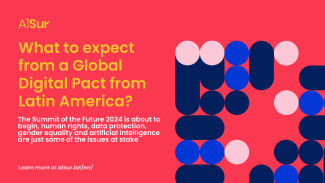Summit of the Future: What to expect from a Global Digital Pact from Latin America?
By Derechos Digitales
The process of creating a Global Digital Compact (GDC) is about to culminate at the Summit of the Future, which will take place in New York on the 22nd and 23rd of this year. Many Latin American organizations, including members of the Al Sur Consortium, have accompanied and contributed to the process throughout two years of discussions and will be present on the occasion. The document, proposed by the Secretary General of the United Nations in 2021 as part of a Common Agenda, seeks to shape global agreements around an “open, free and secure digital future for all people”.
Since its presentation, an intense process of discussions has developed, initially around issues such as connecting all people to the internet, avoiding fragmentation, protecting data, enforcing human rights online, introducing accountability criteria for discrimination and misleading content, promoting the regulation of artificial intelligence and the digital commons as a global public good. Following negotiations between States, which included different cycles of consultations with different stakeholders - at times marked by limitations to the participation of some sectors such as civil society - governments must now agree on a final text.
Al Sur member organizations have actively participated in this process over the last two years. We understand that the Global Digital Pact is a key opportunity to build a global action plan that addresses the multiple inequalities that affect our societies and prevent entire groups of our population from benefiting from technological advances. To this end, it is crucial to recognize the differentiated impact of technologies on women, LGBTQIA+, black and indigenous people, among others, and to create effective mechanisms to guarantee - also for them - an open, free and safe digital space.
In our contributions we have been emphasizing some points that we consider key taking into account the Latin American reality: the need to respect and apply human rights in the digital context; the urgency of moving towards concrete commitments to meaningful connectivity; the importance of data protection and the relevance of rights-based regulatory frameworks to address the advancement of artificial intelligence. Our vision is that the human rights framework and a cross-cutting gender perspective are fundamental to building an agreement that aims for an equitable and just digital future for all people.
As we approach the Summit of the Future, we note important advances in the most recent versions of the text, for example in relation to references to international human rights law, gender equality and equity, more generally, as cross-cutting principles, recognition of the processes derived from the Summits on the Information Society and support for the Internet Governance Forum, among others that we have been highlighting from civil society contributions.
At the same time, we consider that there is still room for improvement in aspects such as the need to prohibit mass surveillance and ensure that targeted surveillance complies with international law criteria (with specific reference to the criteria of necessity, proportionality and legality), the recognition of the criteria applicable to restrictions on Internet access and freedom of expression in line with existing international standards, the explicit recognition of privacy and data protection principles. At the same time, it is essential to apply balanced approaches that include both respect for basic guarantees in this area and the promotion of the use of data for different purposes. Likewise, a better balance is required between commitments to human rights and the promotion of artificial intelligence and other emerging technologies. We also regret the absence of a clear commitment to limit the circulation of technologies that do not comply with existing human rights standards, as recognized in the most recent UN General Assembly resolution on artificial intelligence, among others.
In terms of gender perspective, to be effective, it should not only be applied as a stand-alone objective, but should be integrated into all aspects of policy and program development. Although the stand-alone principle is maintained, the document could be more detailed in its approach by including gender-specific language in each of the sections on objectives, commitments and actions provided for in the Pact. We note with concern that some essential references to gender equality have been removed in the latest versions of the text. For example, the only reference to gender equality in the goal on artificial intelligence has been removed, as well as the reference to the prevention of technology-facilitated gender-based violence (TFGBV). According to the feminist principles presented by several civil society organizations - including members of Al Sur, such as Derechos Digitales - at the beginning of the process, the gender perspective is essential to avoid deepening pre-existing inequalities.
Ensuring a human rights and gender perspective in this document is fundamental, as it will become a key pillar in defining international engagement around the advancement of digital rights.
It is important to mention that throughout the negotiations, the text has undergone multiple changes. During this process, States have broken the silence on several occasions on different paragraphs on which it was intended to reach a consensus, which has generated new rounds of discussions and modifications to the document. A few days before the start of the Summit of the Future, uncertainty persists regarding the final text and its adoption. Since the presentation of a first version of the text in May 2024, at least three revisions have already been published on the official website, while others are circulating informally. Consensus seems difficult.
To be effective, the Global Digital Pact must articulate a set of previously established commitments and mechanisms, such as the agreements derived from the Summits on the Information Society, including the Internet Governance Forum (IGF) and its regional and national processes. In addition, it must build the confidence of the different sectors in its implementation. Ensuring concrete mechanisms for effective participation, particularly of civil society, and strengthening transparency and accountability at every stage following its adoption should be non-negotiable elements of any possible agreement in the coming week.
Unfortunately, we have identified many shortcomings in this regard throughout the text-building process. The participation of civil society in discussions such as this should not be understood as an act of goodwill, but rather as a structuring part of any global effort of the ambition of the Global Digital Compact - which requires not only commitments, but specific and well-defined mechanisms.
In the coming days, we have an intense agenda of activities and meetings in the framework of the Summit of the Future and, with a view to the implementation of the agreements that will be reached on the occasion, we will seek to ensure that the Global Digital Pact fulfills its promises and represents a significant contribution to Latin America.
Timeline and main inputs from Latin America
As we prepare for the discussions that will take place in the coming days, below we summarize some key moments in the process of building a Global Digital Pact and the inputs offered by Al Sur and its members from Latin America.
2022 - 2023 | First consultation period
This initial consultation period included several informal listening modalities led by the co-facilitators of the process in conjunction with the UN Secretary General's Office of the Envoy for Technologies. The Al Sur Consortium and its members actively participated in the process, for example, by submitting an input to the written consultation. In addition, some member organizations of the consortium, such as Coding Rights, Derechos Digitales and TEDIC, participated in the regional consultation of the Americas held in Mexico City in February 2023, which generated an input to the written consultation. Finally, organizations such as Derechos Digitales and R3D, participated in the thematic consultations held as part of the process. Inputs have been sent to the written consultation process from LACIGF, which in the 2022 edition was focused on developing key messages from Latin America to the Global Digital Compact.
- Al Sur Consortium Contribution
- Contribution from the Consultation for the Americas
- Contribution from the LACIGF community
- Declaration of Digital Rights during the thematic session on Internet Governance
- Digital Rights Declaration during the thematic session on human rights
- Digital Bill of Rights during the thematic session on Artificial Intelligence
2024 | New consultation period and first drafts
A new cycle of consultations was opened as of February 2024, again with the active participation of Al Sur and its members. Comments were first submitted on the draft structure of the Compact and then substantive contributions on its content, with Al Sur's participation in the March 1st session, highlighting the key elements of its written contribution.



